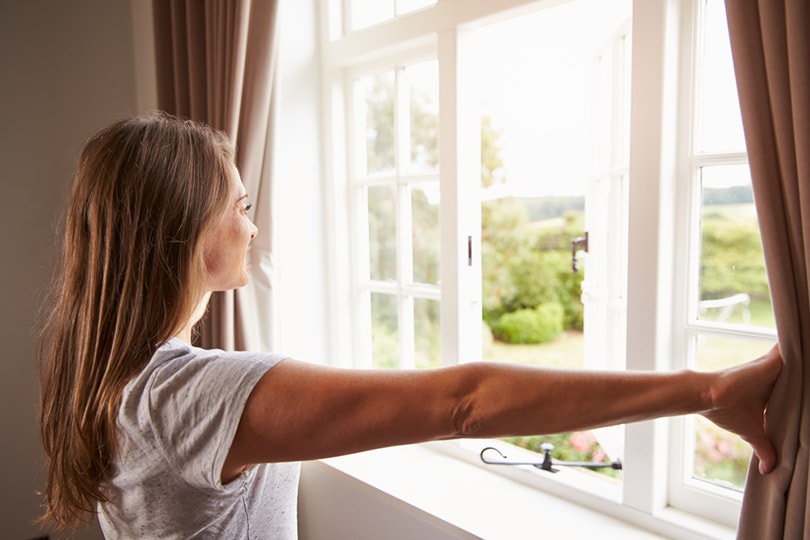How to Improve Indoor Air Quality: 7 Tips and Tricks
-
Kristin Hitchcock
- Last updated:

It’s a common misconception that outdoor air is more polluted than indoor air. After all, we all know about how cars and factories release emissions and lower the outside air quality. However, indoor air is often 2–5 times more polluted than outdoor air.
For the most part, this is largely because indoor air is more concentrated and never leaves. There is no wind pushing indoor air away and diluting it with fresh air. Also, there aren’t many trees and plants indoors, which naturally clean the air that is inside.
Luckily, there are many ways to improve the air quality in your home. Many of them are extremely easy, so there are a few reasons to not follow them. Follow our tips below for easy ways to improve your indoor air quality.
The 7 Tips & Tricks on How to Improve Indoor Air Quality
1. Open the Windows

We already discussed how outdoor air is usually cleaner than indoor air (sometimes by nearly 1,000%). Therefore, it only makes sense that opening windows and airing out your home would help remove many of the pollutants. Opening your windows allows fresh air to come in and push all the stale air out. It’s an easy (and free) way to freshen up your home.
You can also use fans to help move the indoor air out, especially if it is not a breeze day. Areas like bedrooms and kitchens are especially important to air out, as they tend to have the most contaminants. Opening the windows while you’re cooking helps remove cooking fumes, for instance.
Even in the cities, outdoor air is often much cleaner than indoor air. Therefore, you should always attempt to open your windows for at least a few minutes each day.
2. Get an Air Purifier
While air purifiers are expensive, they are made explicitly to clean up indoor air quality. Use these air purifiers where you spend much of your time, such as in the living room and bedroom. You probably don’t need one in your bathroom, though, or other little-used areas.
There are several types of air purifiers out there. Sadly, their effectiveness is often tied directly to their cost. It is better to save up a bit longer and invest in a good air purifier than to purchase a bunch of cheaper models. Some inexpensive models may not even filter out some of the most common allergens.
3. Add Some Greenery

Adding indoor plants is a great way to filter out your indoor air. These indoor plants filter the air inside just like outside plants filter out the outdoor air. Some plants are better at cleaning the air than others, though. Therefore, you may want to be careful about what plants you select.
For instance, ivy is especially good at filtering out indoor contaminants. Plus, it looks rather nice indoors, especially when it is draped across cabinets or other shelves. It also doesn’t need much light, so you don’t have to place it by a window.
However, you should be careful with plants if you have a mold allergy. Many plants prefer moist soil, which can harbor the growth of mold.
4. Change Filters
If you have a heating system, you likely have built-in filters to help clean the air. These filters should be changed regularly to ensure that they are catching all of the dust and airborne irritants in your home. You don’t want these allergens simply re-circulated, so cleaning them is vital.
We also recommend cleaning out your ducts regularly, as they contain a lot of trapped dust and debris. These can be re-introduced into your home’s air, so it is best to remove them.
5. Keep Your Home Clean

A cluttered, dirty home will often contribute to poor air quality. You should aim to keep your home as clean as possible to reduce the number of pollutants that can end up in your air. This is especially true for pet dander, dust, and mold. All of these contaminants can circulate in your home’s air and lower the quality.
We recommend vacuuming your rugs and carpet at least once or twice a week. These carpets can hold onto dust and debris very easily, which can then be released back into the air. If possible, opt for hard flooring that doesn’t hold onto dust or mold quite as much.
Regularly clean any fabrics in your home. This includes bedding and drapes, which can also hold onto allergens. If you have pets, these surfaces can be even more troublesome.
Keep clutter clean and throw away items that you do not need. Most things in your house provide more places for dust to hide, which can be troublesome.
6. Use Fans
As the weather permits, you should run window and attic fans to help improve the air quality. Local bathroom and kitchen fans can also be helpful, but be sure to clean them regularly or they can do more harm than food. Using fans is particularly important if you’re doing something that can decrease air quality, like painting or cooking.
Having a few fans in your home to move around and exhaust air when necessary, can be helpful. You don’t necessarily need them on all the time, but they can increase ventilation rates and clear pollutants.
Most residential heating and cooling systems do not bring in outside air. Therefore, do not rely on them or their fans to increase your air quality. While the filters attached to them can help remove pollutants, they do not improve ventilation.
7. Control the Source of Contaminants

An easy way to improve your home’s air quality is to reduce the number of pollutants in the air, to begin with. Doing this can seem a bit complicated, but it is relatively straightforward.
- Tobacco products
- Fumes from new flooring, upholstery, mattresses, pressed wood products, etc.
- Products for personal care or cleaning (such as hair spray, bleach, etc.)
- Central heating or cooling systems
- Pesticides
- Outdoor air pollutants (car exhausts)
- Combustion appliances
You cannot eliminate all of these sources from your home. However, some appliances can be adjusted to produce fewer pollutants, and you can be more aware of bringing new items into your home. When possible, it is best to air out new items before you bring them inside your home.
 Conclusion
Conclusion
- Ventilate indoor air outside, replacing it with fresh air
- Filter the existing air in your home
- Reduce the pollutants produced in your home
All the methods for improving your home’s air quality are based on these three concepts. Opening windows and using fans exchanges indoor air for outdoor air. Adding air filters and plants helps filter out the air in your home. Being aware of the fumes from new items and reducing the use of combustion cooking helps decrease the number of pollutants produced.
By taking a few steps in each of these categories, you can easily improve your home’s air quality a lot.
Featured Image Credit: islandworks, Pixabay
Contents

 Conclusion
Conclusion